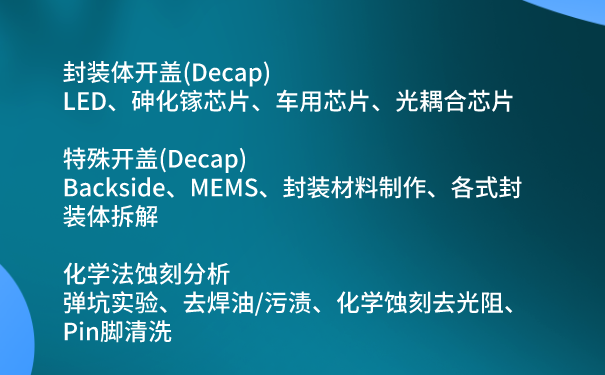What is chip opening? Which testing institutions are more reliable?
Date:2021-09-24 14:33:00 Views:6047
IC opening, also known as opening, sealing, capping, decap, decapsulation, IC unsealing adhesive, refers to removing the epoxy resin or other packaging materials on the IC die (die, wafer), exposing the die, and preparing for IC decryption, FIB, photographing or preventing decryption. Normal opening does not damage the function of the master chip. Unsealing and capping is a physical-chemical test, which dissolves the epoxy resin colloid on the outer surface of the chip and retains the complete grain or gold wire, so as to check the important marks, layout, process defects, etc. on the grain surface.
We usually do design or quality. Sometimes we encounter invalid products, the samples are in our hands, and the internal structure can't be seen. What should we do at this time? At this time, there are two options. One is to take X-ray and use the gray difference to see the internal structure layout and obvious defects. Of course, X-ray is not omnipotent. For example, the aluminum wire in epoxy resin can not be photographed. At this time, there is a method with low cost and more obvious effect to choose, that is Kaifeng.
Do you have to open the chip? The purpose of sample unsealing is to expose the internal device chip of the package for further electrical detection and morphology observation of the chip surface. Nondestructive failure analysis technologies such as X-ray fluoroscopy and scanning acoustic microscopy can only solve limited failure analysis problems (such as inner lead fracture, chip bonding failure, etc.) Due to the opacity of packaging materials such as single component and multilayer wiring structure, anatomical sample preparation technology must be used to realize the visibility and detectability of chip surface and interior.

As Kaifeng will use dangerous chemical reagents, it is recommended that inexperienced people do not try easily. How to choose a reliable testing organization? As the so-called technology industry has specialization, we can go to a qualified third-party laboratory.
First, the third-party laboratory has rich experience. The third-party laboratory is specialized in testing and analysis. There are many cases and samples. With the accumulation of natural experience, it is easier to find and find problems.
Second: there are perfect protective measures. The third-party laboratory is not simply and roughly opened. They have ventilation and drainage system, gas mask, protective gloves, protective clothing, operation platform and other relatively perfect equipment and facilities to ensure the safety of operators and operation environment.
Third: sound equipment. The third-party laboratory can first use X-ray to roughly see the internal layout, binding material, etc., then use laser unsealing machine to cut it to the chip position, and then use acid corrosion for a few seconds to clean it. In this way, a clean and corrosion-free chip is displayed in front of us.
The above is the related content of "chip cover opening detection" brought by the core creation detection. Through this article, I hope it can be helpful to you. If you like this article, you might as well continue to pay attention to our website, and we will bring more wonderful content later. If you have any needs related to the inspection and testing of electronic products, please call Chuangxin testing, and we will serve you wholeheartedly.
Chuangxin testing always adheres to the purpose of "professional, authoritative, efficient and innovative". It has invested heavily in purchasing international advanced testing equipment. The testing is in strict accordance with international testing standards and methods. It has obtained CNAs certification and international mutual recognition qualification. Its customer base covers many countries and regions at home and abroad. It is a professional IC testing institution with excellent quality and high popularity in China.




 Weixin Service
Weixin Service

 DouYin
DouYin
 KuaiShou
KuaiShou





















